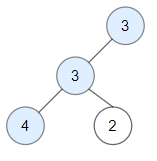LeetCode in Kotlin
1448. Count Good Nodes in Binary Tree
Medium
Given a binary tree root, a node X in the tree is named good if in the path from root to X there are no nodes with a value greater than X.
Return the number of good nodes in the binary tree.
Example 1:

Input: root = [3,1,4,3,null,1,5]
Output: 4
Explanation: Nodes in blue are good.
Root Node (3) is always a good node.
Node 4 -> (3,4) is the maximum value in the path starting from the root.
Node 5 -> (3,4,5) is the maximum value in the path
Node 3 -> (3,1,3) is the maximum value in the path.
Example 2:

Input: root = [3,3,null,4,2]
Output: 3
Explanation: Node 2 -> (3, 3, 2) is not good, because “3” is higher than it.
Example 3:
Input: root = [1]
Output: 1
Explanation: Root is considered as good.
Constraints:
- The number of nodes in the binary tree is in the range
[1, 10^5]. - Each node’s value is between
[-10^4, 10^4].
Solution
import com_github_leetcode.TreeNode
/*
* Example:
* var ti = TreeNode(5)
* var v = ti.`val`
* Definition for a binary tree node.
* class TreeNode(var `val`: Int) {
* var left: TreeNode? = null
* var right: TreeNode? = null
* }
*/
@Suppress("NAME_SHADOWING")
class Solution {
private var count = 0
private fun traverse(root: TreeNode?, max: Int) {
var max = max
if (root == null) {
return
}
if (root.`val` >= max) {
count += 1
max = root.`val`
}
traverse(root.left, max)
traverse(root.right, max)
}
fun goodNodes(root: TreeNode?): Int {
traverse(root, Int.MIN_VALUE)
return count
}
}

